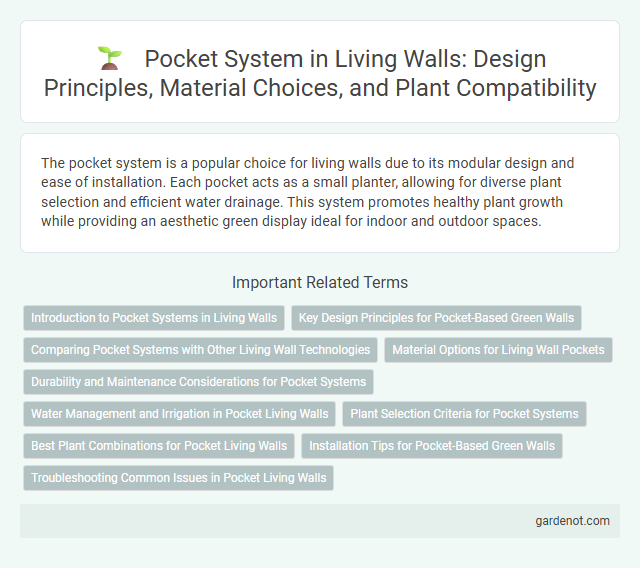The pocket system is a popular choice for living walls due to its modular design and ease of installation. Each pocket acts as a small planter, allowing for diverse plant selection and efficient water drainage. This system promotes healthy plant growth while providing an aesthetic green display ideal for indoor and outdoor spaces.
Introduction to Pocket Systems in Living Walls
Pocket systems in living walls consist of lightweight, modular fabric or felt containers that securely hold soil and plants while facilitating root aeration and water drainage. These pockets enable versatile vertical gardening on various surfaces, optimizing space in urban environments and improving air quality by supporting diverse plant species. Their design simplifies installation and maintenance, making them an efficient solution for green walls in both residential and commercial settings.
Key Design Principles for Pocket-Based Green Walls
Pocket-based green walls utilize modular fabric pockets made from durable, breathable materials that promote healthy root aeration and water retention. Key design principles emphasize proper spacing and orientation to ensure even light exposure and prevent overcrowding, which supports optimal plant growth and maintenance. Incorporating an efficient irrigation system with drainage control is essential to maintain moisture balance and prevent root rot in pocket systems.
Comparing Pocket Systems with Other Living Wall Technologies
Pocket systems offer superior flexibility and ease of installation compared to traditional living wall technologies such as modular panel systems and tray systems. These systems utilize fabric pockets that promote better root aeration and water drainage, reducing plant stress and enhancing growth rates. Unlike rigid structures, pocket systems allow for customizable plant arrangements and are lightweight, making them ideal for both indoor and outdoor vertical gardens.
Material Options for Living Wall Pockets
Living wall pockets are primarily made from durable materials such as felt, PVC, and recycled fabrics, chosen for their water resistance and breathability to support plant health. Felt pockets offer excellent moisture retention and root aeration, making them ideal for various indoor and outdoor environments. PVC options provide robust structural support and longevity, especially in wetter climates, while recycled fabric pockets emphasize sustainability without compromising durability.
Durability and Maintenance Considerations for Pocket Systems
Pocket systems for living walls feature high durability due to robust materials like UV-resistant, breathable fabrics that prevent tearing and microbial growth. Maintenance involves easy access for plant care and periodic cleaning to avoid dirt accumulation and ensure optimal water drainage. Selecting pocket systems with reinforced stitching and water-resistant backing enhances longevity and reduces the frequency of repairs.
Water Management and Irrigation in Pocket Living Walls
The pocket system in living walls enhances water management by utilizing individual fabric pockets that retain moisture and distribute water evenly to plant roots. This design reduces water runoff and evaporation, promoting efficient irrigation cycles and minimizing water waste. Advanced systems often integrate drip irrigation within the pockets to ensure precise water delivery, supporting healthy plant growth and conserving resources.
Plant Selection Criteria for Pocket Systems
Plant selection for pocket systems in living walls prioritizes species with shallow root systems and high drought tolerance to ensure optimal growth within limited soil volumes. Native and low-maintenance plants such as ferns, succulents, and trailing vines are ideal due to their adaptability and resilience in vertical environments. Light requirements and microclimates must be assessed carefully to match plant species with pocket placement, promoting healthy development and reducing irrigation needs.
Best Plant Combinations for Pocket Living Walls
Succulent and fern varieties create an ideal balance for pocket living walls, offering contrasting textures and colors that enhance visual appeal. Incorporating air plants alongside trailing ivy maximizes space while ensuring efficient air circulation and minimal maintenance. Native wildflowers and herbs boost biodiversity and provide seasonal interest, supporting a sustainable pocket system environment.
Installation Tips for Pocket-Based Green Walls
Pocket-based green walls require secure mounting on a sturdy, waterproof backing to support plant weight and prevent water damage. Ensure proper irrigation by installing drip systems or hand-watering techniques that reach all pockets evenly to avoid dry spots or overwatering. Regular maintenance includes checking pockets for soil compaction and root growth, allowing healthy plant development in the modular pocket structure.
Troubleshooting Common Issues in Pocket Living Walls
Pocket living walls often face common issues such as water drainage problems, uneven plant growth, and pest infestations. Proper troubleshooting involves checking irrigation systems for clogs, ensuring adequate sunlight distribution, and regularly inspecting pockets for pests or fungal infections. Maintaining optimal moisture levels and using appropriate fertilizers can also prevent plant stress and promote healthy growth.
Pocket system Infographic

 gardenot.com
gardenot.com